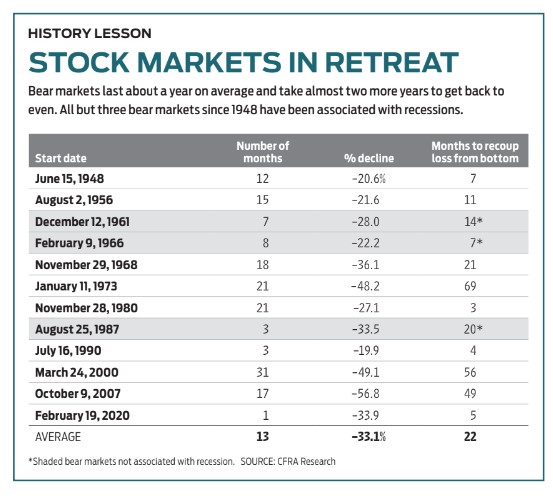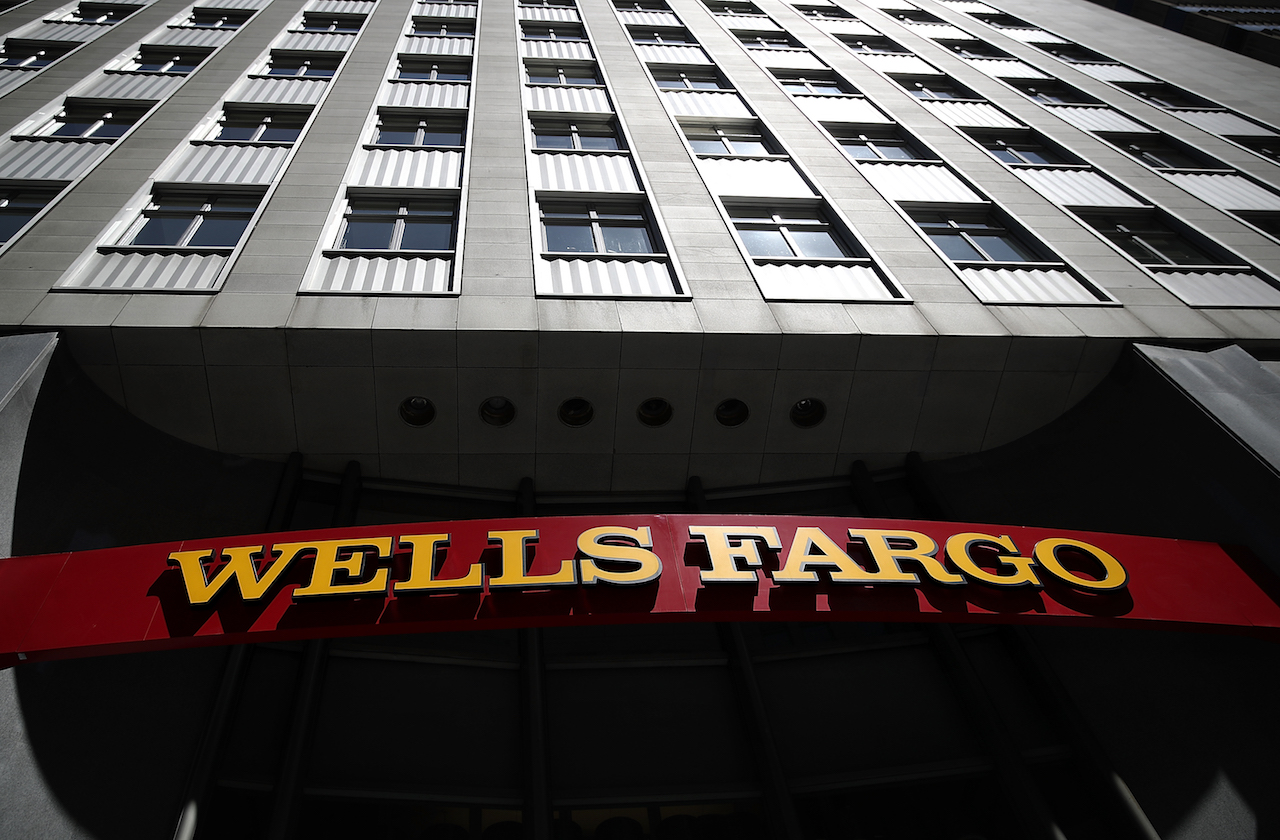Smart Investing in a Bear Market
Here's how to make the most of today’s dicey market.


The bear that's been lurking on Wall Street all spring finally stepped out of the shadows on June 13, taking hold of what is now officially a bear market. The S&P 500 dropped nearly 4% in a day, erasing $1.28 trillion in a single trading session.
Since its record high on Jan. 3, the broad-market benchmark is down 21.8% – eclipsing the 20% bear-market threshold. That closed the books on the COVID-era bull market that took off in March 2020 and delivered a 114.4% price gain.
The market had tiptoed close to bear territory in May, then mounted a convincing rally. Bear-market rallies are fairly common, with 17 of 26 bear markets since 1929 recording upswings with gains of 10% or more, according to BofA.

Sign up for Kiplinger’s Free E-Newsletters
Profit and prosper with the best of expert advice on investing, taxes, retirement, personal finance and more - straight to your e-mail.
Profit and prosper with the best of expert advice - straight to your e-mail.
But a lack of bullish follow-through points to an increased risk of lower lows, according to technical research strategist Stephen Suttmeier at BofA Securities. The next stop: roughly 3,500 on the S&P 500, he says, a drop of 27% from the record high. And don't be caught off guard by more volatility – in both directions, he adds. "Midterm-election years are very challenging, with big rallies and big declines."
Reading the Stock Market's Signals
A key question is whether the market's recent malaise is forecasting a recession or not, says Sam Stovall, chief investment strategist at research firm CFRA. Nine of the 12 bear markets since 1948 have been triggered by impending recessions, he says. Those ended up being deeper, on average, than the three not associated with recessions – an average 35% decline versus a 28% drop, respectively. And they lasted longer – 15 months, on average, compared with six months. For now, Kiplinger is in the camp that says the economy will skirt a recession – with the caveat that a few unexpected shocks could tip the scales.
Strategists at investment firm Nuveen believe the economy is headed for either a soft landing (averting a recession) or a mild recession.
In the first case, the Federal Reserve keeps to the moderately aggressive rate-hike schedule that is already priced into financial markets. Inflation moderates, economic growth stays positive, and the job market weakens slightly but remains robust. That scenario favors stocks of companies with businesses that can grow even in an economy that's slowing – the so-called growth stocks that have struggled lately. In a mild recession, the Fed will have succeeded in fighting inflation, but at the expense of economic growth, which turns negative. Then, Nuveen would favor a blend of stocks that are value-oriented and those with growing dividends.
When the mood turns dark on Wall Street, a contrarian view can pay off. A compilation of sentiment surveys shows that optimism about the market across both Main Street and Wall Street was recently lower than about 94% of the time since 1960, notes Jim Paulsen, chief investment strategist at the Leuthold Group. "I get it. We had a virus with an ongoing death count that stuck all of us in our basements and made our major downtowns ghost towns. Add the weirdest monetary and fiscal policies ever, then throw in runaway inflation, shortages of everything and, for good measure, a war."
Many of those conditions are changing for the better, says Paulsen, setting up a promising, counterintuitive strategy. "Historically, when confidence was this low, the bear was close to expiring, and, looking ahead the next 12 months, it typically signifies a uniquely positive occasion for stock investors," he says. Indeed, corporate insiders are betting on better days, according to Leuthold research, having stepped up buying lately.
Pay Attention to Strong Fundamentals
Many stocks have been battered more than their profit outlook warrants, according to an analysis from investment firm Credit Suisse. Stocks whose prices have collapsed even as the outlook for their earnings has improved – drastically lowering their price-earnings ratio – include semiconductor producer Advance Micro Devices (AMD, $106), pharmaceutical research firm Charles River Labs International (CRL, $243), industrial company Generac (GNRC, $269) and luxury goods purveyor Tapestry (TPR, $35). Stock sectors where P/Es have contracted the most include communications services, consumer discretionary and tech.
The caveat, of course, is that earnings expectations could turn out to be overly optimistic.
Bargain hunting is a big part of a bear-market playbook. It's a good idea to keep a list of stocks you'd like to own at the right price so you're prepared to pounce when the market delivers a bargain.
Don't abandon strategies that have served you well in good times. Dollar-cost averaging, for example – the practice of investing a set amount at regular intervals – works even better in volatile markets, allowing you to buy more shares when prices are low and thereby lowering your average cost per share over time. It also helps take emotion out of the decision to buy. You're already dollar-cost averaging if you're a 401(k) investor and your contributions are on autopilot. Now is not the time to turn that off – in fact, it might be a good time for those with a long-term horizon to increase the amount of their regular contributions.
Diversification is another tenet to hold tight to – a challenge lately, considering that both stocks and bonds have been sinking at the same time for much of the year. But especially if we're headed for a recession, diversification can cushion the blow to your portfolio. Wells Fargo Investment Institute found that a portfolio with a wide mix of investments outperformed the S&P 500 (representing a stock-only portfolio) by an average of seven percentage points over the past several recessions.
For investors with taxable accounts, bear markets provide the lemons for lemonade you can make at tax time. Stock losses realized now can be offset against gains to reduce your capital gains tax bill. Or you might consider converting your traditional IRA to a Roth IRA while the value of your portfolio is down, lowering the taxes you'll pay now in exchange for tax-free withdrawals in retirement.

Get Kiplinger Today newsletter — free
Profit and prosper with the best of Kiplinger's advice on investing, taxes, retirement, personal finance and much more. Delivered daily. Enter your email in the box and click Sign Me Up.

Anne Kates Smith brings Wall Street to Main Street, with decades of experience covering investments and personal finance for real people trying to navigate fast-changing markets, preserve financial security or plan for the future. She oversees the magazine's investing coverage, authors Kiplinger’s biannual stock-market outlooks and writes the "Your Mind and Your Money" column, a take on behavioral finance and how investors can get out of their own way. Smith began her journalism career as a writer and columnist for USA Today. Prior to joining Kiplinger, she was a senior editor at U.S. News & World Report and a contributing columnist for TheStreet. Smith is a graduate of St. John's College in Annapolis, Md., the third-oldest college in America.
-
 Two Don'ts and Four Dos During Trump's Trade War
Two Don'ts and Four Dos During Trump's Trade WarThe financial rules have changed now that tariffs have disrupted the markets and created economic uncertainty. What can you do? (And what shouldn't you do?)
By Maggie Kulyk, CRPC®, CSRIC™
-
 I'm Single, With No Kids: Why Do I Need an Estate Plan?
I'm Single, With No Kids: Why Do I Need an Estate Plan?Unless you have a plan in place, guess who might be making all the decisions about your prized possessions, or even your health care: a court.
By Cynthia Pruemm, Investment Adviser Representative
-
 What Is the Buffett Indicator?
What Is the Buffett Indicator?"It is better to be roughly right than precisely wrong," writes Carveth Read in "Logic: Deductive and Inductive." That's the premise of the Buffett Indicator.
By Charles Lewis Sizemore, CFA
-
 CPI Report Puts the Kibosh on Rate Cuts: What the Experts Are Saying About Inflation
CPI Report Puts the Kibosh on Rate Cuts: What the Experts Are Saying About InflationCPI Consumer price inflation reared its ugly head to start the year, dashing hopes for the Fed to lower borrowing costs anytime soon.
By Dan Burrows
-
 Fed Leaves Rates Unchanged: What the Experts Are Saying
Fed Leaves Rates Unchanged: What the Experts Are SayingFederal Reserve As widely expected, the Federal Open Market Committee took a 'wait-and-see' approach toward borrowing costs.
By Dan Burrows
-
 CPI Report Keeps the Fed on Track: What the Experts Are Saying About Inflation
CPI Report Keeps the Fed on Track: What the Experts Are Saying About InflationCPI Disinflation in key areas of consumer prices should help the Federal Reserve stick to its policy path of gradual cuts to interest rates.
By Dan Burrows
-
 Why Wells Fargo's Revenue Miss Isn't Worrying Wall Street
Why Wells Fargo's Revenue Miss Isn't Worrying Wall StreetWells Fargo is one of the best S&P 500 stocks Wednesday even after the big bank's top-line miss. Here's what you need to know.
By Joey Solitro
-
 Blowout December Jobs Report Puts Rate Cuts on Ice: What the Experts Are Saying
Blowout December Jobs Report Puts Rate Cuts on Ice: What the Experts Are SayingJobs Report The strongest surge in hiring since March keeps the Fed on hold for now.
By Dan Burrows
-
 Constellation Energy Stock Soars on Its $26 Billion Buy. Here's Why Wall Street Likes the Deal
Constellation Energy Stock Soars on Its $26 Billion Buy. Here's Why Wall Street Likes the DealConstellation Energy is one of the best S&P 500 stocks Friday after the utility said it will buy Calpine in a cash-and-stock deal valued at $26 billion.
By Joey Solitro
-
 Fed Sees Fewer Rate Cuts in 2025: What the Experts Are Saying
Fed Sees Fewer Rate Cuts in 2025: What the Experts Are SayingFederal Reserve The Federal Reserve cut interest rates as expected, but the future path of borrowing costs became more opaque.
By Dan Burrows